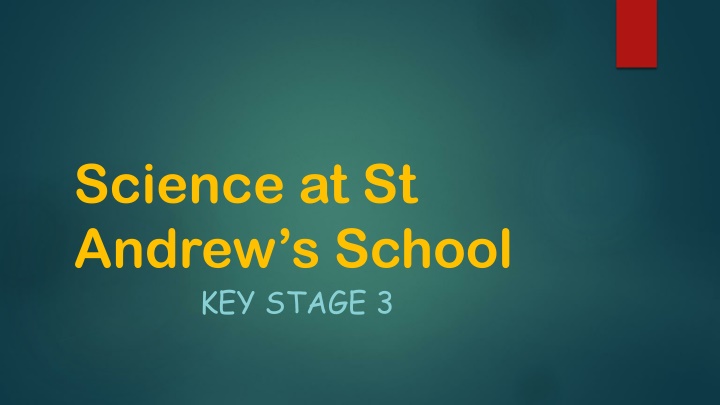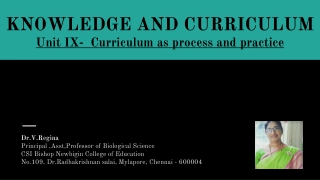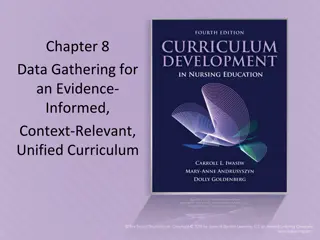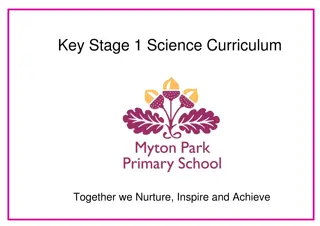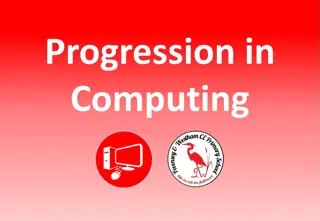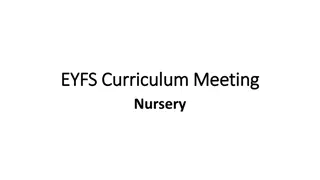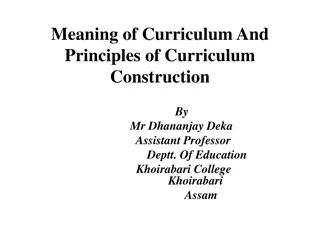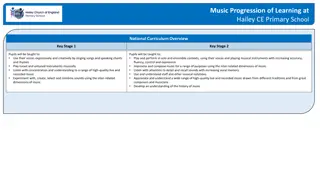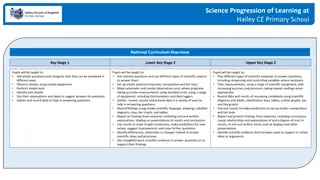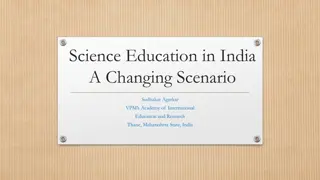St. Andrew's School Key Stage 3 Science Curriculum
This curriculum covers a range of topics in science for Key Stage 3 students, including living things and habitats, energy and fuels, cells, and more. Students learn about the interconnectedness of organisms in ecosystems, the fundamentals of cells, and the importance of a healthy diet. The curriculum is designed to provide a well-rounded understanding of scientific concepts and their applications.
Download Presentation

Please find below an Image/Link to download the presentation.
The content on the website is provided AS IS for your information and personal use only. It may not be sold, licensed, or shared on other websites without obtaining consent from the author.If you encounter any issues during the download, it is possible that the publisher has removed the file from their server.
You are allowed to download the files provided on this website for personal or commercial use, subject to the condition that they are used lawfully. All files are the property of their respective owners.
The content on the website is provided AS IS for your information and personal use only. It may not be sold, licensed, or shared on other websites without obtaining consent from the author.
E N D
Presentation Transcript
Science at St Andrew s School KEY STAGE 3
Key Stage 3 Year 7- Autumn term 7C Environment & Feeding -Living things & their habitats The differences in the life cycles of a mammal, an amphibian, an insect and a bird. The life process of reproduction in some plants and animals and how living things (including micro-organisms, plants and animals) are classified using common observable characteristics and based on similarities and differences and classification keys into broad groups. Interdependence of organisms in an ecosystem, including food webs and the importance of plant reproduction through insect pollination in human food security. Recognise how environments can change and that this can sometimes pose dangers to living things. How organisms affect, and are affected by, their environment, including the accumulation of toxic materials.
Key stage 3 Year 7 - Spring Term 7I Energy & Fuels Students can associate the brightness of a lamp or the volume of a buzzer with the number and voltage of cells used in the circuit. Can compare and give reasons for variations in how components function, including the brightness of bulbs, the loudness of buzzers and the on/off position of switches. Can use recognised symbols when representing a simple circuit in a diagram. Some students will learn about simple chemical reactions. (Unit 7F)
Key stage 3, Year 7- Summer Term 7A Cells How cells are the fundamental unit of living organisms, including how to observe, interpret and record cell structure using a light microscope. The functions of the cell wall, cell membrane, cytoplasm, nucleus, vacuole, mitochondria and chloroplasts. Compare and understand the similarities and differences between plant and animal cells. The role of diffusion in the movement of materials in and between cells. The structural adaptations of some unicellular organisms and the hierarchical organisation of multicellular organisms: cells - tissues - organs - systems - organisms.
Key Stage 3, Year 8 In Year 8 the students move on to an individually tailored Framework of the Science curriculum which at each level includes 12 units that cover Physics, Chemistry and Biology. This allows the students some personal choice in Science and to follow their interests, whilst gaining a well-rounded understanding of Science and its applications in the world we live in. Students are not expected to cover every unit but are encouraged to work at a pace suitable to them. Relevant AQA Unit Scheme Awards are also woven into the curriculum as appropriate and enable students to gain certificates for their work.
Key Stage 3 Year 8 - Autumn Term 8A Food & Digestion Students will learn the content of a healthy human diet: carbohydrates, lipids (fats and oils), proteins, vitamins, minerals, dietary fibre and water, and why each is needed. Explain the calculations of energy requirements in a healthy daily diet and be able to describe the consequences of imbalances in the diet, including obesity, starvation and deficiency diseases. Describe the tissues and organs of the human digestive system, including adaptations to function and how the digestive system digests food using enzymes simply as biological catalysts. The importance of bacteria in the human digestive system. Describe how plants make carbohydrates in their leaves by photosynthesis and gain mineral nutrients and water from the soil via their roots.
Key Stage 3 Year 8 - Spring Term 8E Atoms & Elements The properties of the different states of matter (solid, liquid and gas) in terms of the particle model (Dalton), including gas pressure. Understand the differences between atoms, elements/compounds/molecules and their chemical symbols and formulae and also the varying physical and chemical properties of different elements. The Periodic Table, periods and groups. The properties of metals and non-metals and where they are found on the table. Chemical properties of metal and non-metal oxides with respect to acidity. The conservation of mass law and how patterns in reactions can be predicted with reference to the Periodic Table. Some students go onto 8F Compounds & Mixtures
Key Stage 3 Year 8 - Summer Term 8G Rocks & Weathering / 8H Rock Cycle The composition and the structure of the Earth. The rock cycle and the formation of igneous, sedimentary and metamorphic rocks. Recognise that the Earth is a source of limited resources and the efficacy of recycling. Describe the carbon cycle and explain the composition of the atmosphere. Describe the production of carbon dioxide by human activity and the impact of this on the climate. The order of metals and carbon in the reactivity series and the use of carbon in obtaining metals from metal oxides. Explain the properties of ceramics, polymers and composites. Some students may move onto 8I Heating & Cooling and 8J Magnets & Electromagnets.
Key Stage 3 Year 9 - Autumn Term 9B Fit & Healthy The structure and functions of the human skeleton, including support, protection, movement and making blood cells. The biomechanics the interaction and function of skeleton and muscles, The structure and functions of the gas exchange system in humans and its adaptations. The mechanism of breathing to move air in and out of the lungs and the movement of gases. Look at the impact of exercise, asthma and smoking on the human gas exchange system. Plant gas exchange and the role of leaf stomata in plants The effects of recreational drugs (inc. substance misuse) on behaviour, health and life processes. The differences between aerobic and anaerobic respiration in living organisms, in terms of the reactants, the products formed. The process of anaerobic respiration in humans and micro-organisms, including fermentation.
Key Stage 3 Year 9 - Spring Term 9I Energy & Electricity Types of energy stores and the four main ways of transferring energy, conduction and radiation. How insulators can slow down the rate of energy transfer and how energy transfer diagrams show that energy transfer is not perfect and that some energy is wasted and in what forms. Students understand the meaning of efficiency. The law of conservation of energy says, energy cannot be created or destroyed, only transferred from one store to another . Build both real and virtual electric circuits and explore what voltage is, how to measure it and what happens to voltage as it goes around a circuit. Understand the dangers of high voltage. Know how electricity is made and how it gets into our homes. Know that electricity is made from using other energy sources. Renewable versus non-renewable.
Key Stage 3 Year 9 - Summer Term 9C Plants & Photosynthesis (GCSE Topic 3 & 4 Bioenergetics) The dependence of almost all life on Earth on the ability of photosynthetic organisms, such as plants and algae, to use sunlight by photosynthesis to build organic molecules that are an essential energy store and help maintain safe levels of oxygen and carbon dioxide in the atmosphere. The reactants and products of photosynthesis and the word summary for photosynthesis. The adaptations of leaves for photosynthesis. Unit 9A Inheritance & selection Heredity - where genetic information is transmitted from one generation to the next. Watson, Crick, Wilkins and Franklin model of chromosomes, genes and DNA. The differences between species and the variation between individuals within a species. Some students may move onto 9G Enviro chemistry
